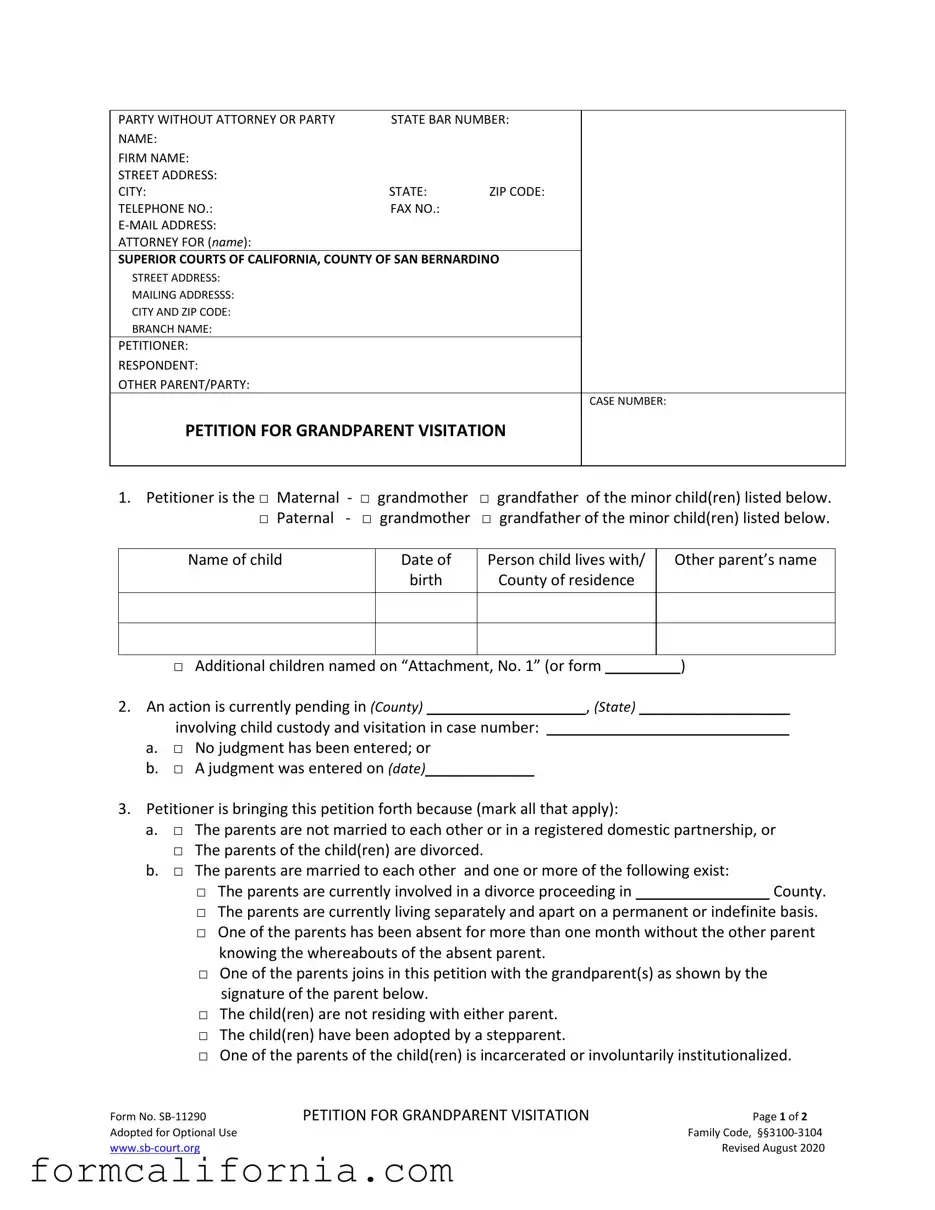The California Judicial Council Form FL-300, Request for Order, shares similarities with the SB-11290 form, particularly in its initiatory purpose within family law disputes. Like the SB-11290, the FL-300 serves as a means for individuals to request the court's intervention on matters such as child custody, visitation (including grandparent visitation), and child support. Both forms necessitate detailed personal and case information and allow petitioners to outline the specific orders they seek from the court. However, the FL-300 form encompasses a broader range of family law issues beyond grandparent visitation.
The California Judicial Council Form FL-105, Declaration Under Uniform Child Custody Jurisdiction and Enforcement Act (UCCJEA), although specifically related to establishing jurisdiction over child custody matters, parallels the SB-11290 in terms of providing crucial case details. It is often used alongside other family law forms, including the SB-11290, to ensure that the court possesses all necessary information to make informed decisions regarding custody and visitation rights. The requirement to fill out the FL-105 form when there is no existing family law case highlights both forms' roles in the comprehensive legal process required to address child-related matters.
The California FL-310, Temporary Orders, form also bears resemblance to the SB-11290 form by offering a mechanism through which immediate and temporary relief can be sought in family law cases, including but not limited to, custody, visitation, and support. While the SB-11290 primarily addresses the establishment of grandparent visitation rights, the FL-310 allows for a wider scope of temporary solutions during the pendency of a case. Both forms play critical roles in enabling parties to petition the court for provisional measures that protect their interests and the welfare of the child involved.
Form FL-160, Property Declaration, although primarily focused on the disclosure of assets and liabilities in the context of dissolution of marriage or legal separation, shares the foundational concept of providing the court with detailed information to make a well-informed decision. The SB-11290 necessitates detailed information on the petitioner, the child, and the nature of the requested visitation, much like how the FL-160 requires detailed listings of property and debts. Both entail comprehensive disclosures for judicial consideration, highlighting the importance of transparency and thoroughness in different legal contexts.
The Declaration Regarding Service of Declaration of Disclosure (Form FL-141) also parallels the SB-11290 in its procedural role within family law cases. This form is used to confirm that parties have exchanged their mandatory financial disclosures, a critical step in proceedings concerning division of property, child support, and spousal support. Although serving a different purpose, the completion and filing of the FL-141, like the SB-11290, are procedural steps that ensure fairness and informed decision-making by providing the court with essential information relevant to the case.
Finally, the Application and Order for Health Insurance Coverage (Form FL-192) is somewhat akin to the SB-11290 in terms of its specific focus within a broader legal area. The FL-192 pertains specifically to the provision of health insurance for a child in family law cases, emphasizing the court's concern with the child's wellbeing, similar to how grandparent visitation rights are considered in the SB-11290. Both forms address particular aspects of a child's welfare within the domain of family law, reflecting the court's multifaceted approach to ensuring a child's overall well-being.
In summary, while each of these forms serves distinct purposes within family law, they collectively underscore the importance of providing detailed information to the court. Whether addressing financial matters, custody, visitation rights, or the child's health and welfare, each form facilitates a specific aspect of the legal process, ensuring that courts can make decisions that are in the best interest of the child and fair to all parties involved.

